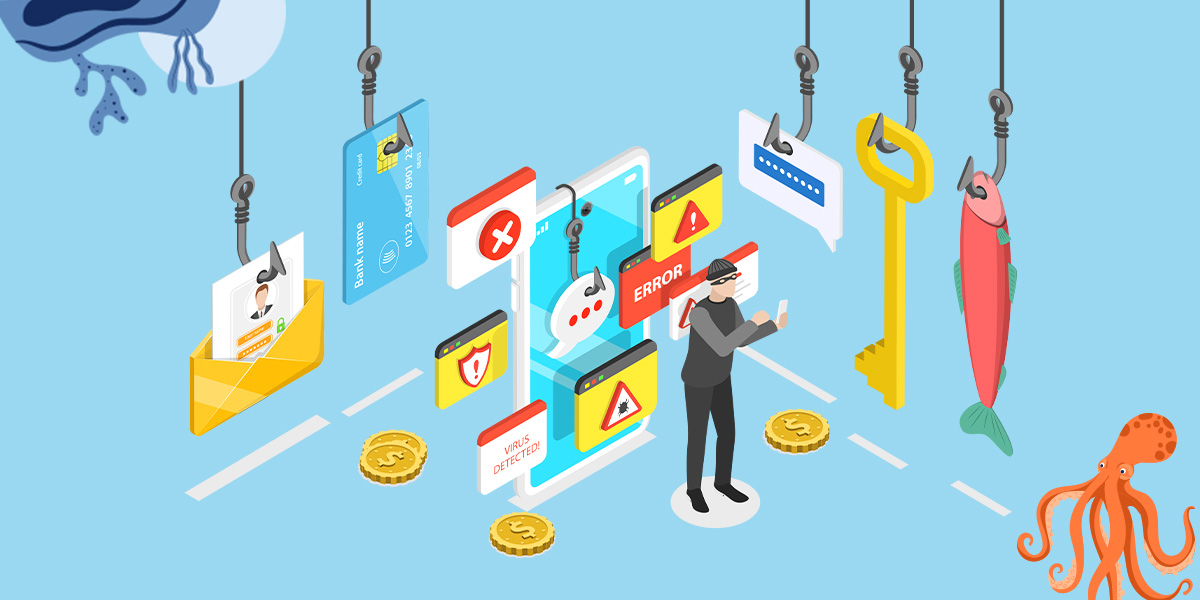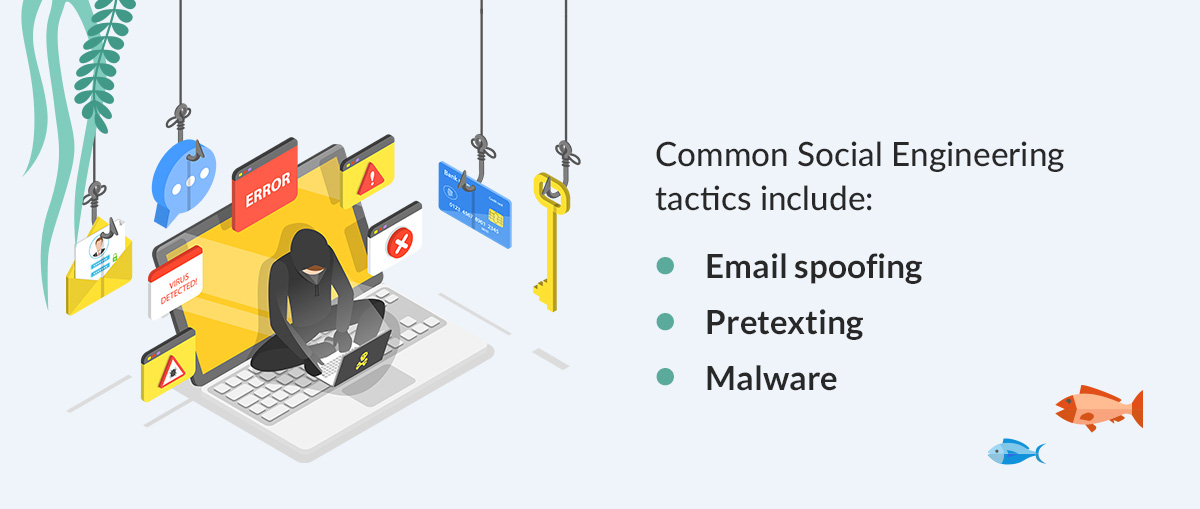


Predicting Future Phishing Trends and Social Engineering



Phishing attacks are increasing continuously as cybercriminals devise new ways of scamming unsuspecting targets. Human error is responsible for most successful attacks because emotions and actions can not be predicted or controlled, despite strict cybersecurity measures.
Managed service providers (MSPs) must stay ahead of phishing and social engineering trends that impact business operations and revenue. The evolving nature of cyber threats creates a need for implementing proactive prevention measures. We'll discuss these and other emerging trends in this article.
Understanding Phishing and Social Engineering
It's important to understand the future of phishing and social engineering in a corporate context. Learn more about each and their developing techniques.
What Is Phishing?
Phishing entails an elaborate attempt by cybercriminals to persuade individuals to perform an action they would otherwise not do. The goal is to trick the individual into providing their personal information for the perpetrator's gain. They achieve this by disguising themselves as sources you would normally trust. When they attempt a phishing attack, you might receive an email or text message that looks credible but is not.
They often entice individuals with exciting promotions, exclusive discounts or competitions and even pose as banks or other financial institutions. This stirs curiosity and interest, making clicking on links and attachments with harmful intent easier. The action may require a password or credit card details to be entered for the competition or to log in to your banking profile. This is how they intercept your details and use them without your knowledge.
What Is Social Engineering?
Social engineering involves deceit and manipulation to gain an individual's trust. The intent is to obtain sensitive information like passwords and credit card details through coercion and false assurance. It can happen in person or over the phone but is most common in online interactions.
The perpetrator relies on the underlying human element of trust and understanding, preying on the vulnerable. By appearing familiar and trustworthy, it's easy to be led astray and fall victim to their scams.
Phishing is a form of social engineering. Some tactics are described below.

Social Engineering Tactics
Numerous tactics are employed by social engineering experts to swindle victims out of money or to obtain their personal information. Common tactics include:
- Email spoofing: Phishing emails are sent from fake accounts with addresses closely resembling the authentic sender's. Small grammatical changes can be noted upon inspection but are often missed. Individuals may reply with personal information if they don't realize the difference.
- Pretexting: This involves impersonating or pretending to be a legitimate company representative like someone calling from a bank or loan company. They might call you to update your details or ask you to confirm your details to proceed. They'll obtain your personal information and use it to impersonate you.
- Malware: Malicious software is downloaded and installed onto your computer once you've unknowingly clicked on a harmful email or website link. A ransom is demanded to remove the virus or you could lose all your information. Large corporations mostly experience this and sometimes pay millions to secure their clients' sensitive data like credit cards and social security details.
Psychological manipulation is the basis of social engineering threats and attacks as perpetrators feed off the curiosity, concern, interest or fear of innocent victims. The act requires highly skilled and deceitful individuals to successfully execute their plans to acquire information from these individuals. They are computer literate with extensive knowledge of the targeted person's business or personal background.
They seem genuine, educated and friendly, characteristics required to earn trust.
Phishing and Social Engineering Trends
An analysis of current social engineering data reveals that phishing attacks are prevalent mostly due to human psychological and emotional vulnerabilities. Some are more susceptible to attacks than others because of predispositions like ease of trust and hopefulness or fear.
Current and emerging trends are rooted in carefully constructed scenarios and schemes. The internet is vast, offering multiple platforms for orchestrated attacks. Assumptions often form part of the issue as individuals may believe that attackers won't engage with them personally. While some may not, they will pay others for the dirty work.
The Role of Emerging Technologies in Phishing and Social Engineering
Emerging technologies play an imperative role in the future of social engineering. We've added recent trending attack forms that have gained traction. They include:
- Targeted attacks: Social media information is easily accessible if accounts are set to public profiles. Cyber attackers study their victims' social media activity. They then attempt to guess their login details to hack into their accounts. Once they're logged in, they may try to impersonate them and gain others' trust by messaging all their contacts. They might persuade them to change their login details because they know and trust the account holder.
- AI and Deepfakes: This technology uses AI to edit imagery and videos to add to existing content. Political figures and celebrities are often at risk as these realistic alterations can damage their reputation. Attackers may threaten to leak content for money.
- Doppelganger websites: These websites look identical to authentic sites but mirror specific pages or content. They can acquire the user's login details when accessed because they think they are accessing the right site.
- Sim swapping: Attackers use the victim's mobile phone to transfer the mobile number to receive text messages with pins and password information to hack their accounts.
- Business email compromise (BEC): This is similar to email phishing or spoofing but the emails sent don't contain attachments. They are text-based and target individuals and businesses. They are dangerous because they can bypass stringent cybersecurity measures and have a high success rate. They are easily intercepted mid-email thread and could appear like a manager or owner is sending the request to issue payments or draw funds.
Predicting Future Trends in Phishing and Social Engineering
Social engineering trends are predicted to adapt as technology advances and cybersecurity measures become stricter. Deepfake and other AI technology may become more advanced because of AI's continued presence in various applications.
Cloud-based platforms are common vectors for attack attempts as phishing mechanisms evolve. These reach mass audiences with the potential to inflict large-scale damage. Attackers are elusive and easily evade detection by masking their activities.
Mobile devices are filled with data-storage functionalities and downloadable and corruptable applications. Downloading apps from unknown sources allows hackers to gain access to user information.
Geopolitical events with global reach make it easy for attackers to target individuals and businesses across the globe. Related societal trends further substantiate the frequency and depth of attacks across the board.
Human vigilance and attention to detail are the main combatant factors in reducing phishing attack success rates. Consistent awareness, training and identification techniques will help mitigate these continuous attempts.
The Importance of Staying Ahead of Phishing and Social Engineering Trends
Inherent risks and consequences of successful phishing and social engineering attacks aren't only confined to the loss of data and money. Further impacts include the psychological damage associated with stress, anxiety, guilt, shame and depression.
An MSP faces certain challenges while preventing evolving threats, including:
- Financial loss
- Data breaches
- Reputational damage
- Inadequate training and cybersecurity measures
The right cybersecurity software helps protect MSPs and their clients. Prevention strategies like comprehensive phishing training and awareness programs promote proactive behavior among staff.
Phin Security — The Solution for MSPs Phishing Prevention and Staying Ahead
Secure your MSP with effective phishing prevention software by Phin Security. We equip users with effective skills and identification techniques to detect phishing and social engineering attacks. This is achieved with special threat intelligence capabilities tailored to the unique needs of each MSP. Phin Security adapts to new attack vectors and constantly develops techniques to stay ahead of cyber security threats.
We are the solution to your social engineering adversities.

.jpg?width=1200&height=600&name=03-CTA-phin-security-the-solution-for-msps-phishing-prevention-and-staying-ahead%20(1).jpg)





Leave a comment: